Zeroing in on 4 Specific Ways Treasurers’ Can Improve Cash Forecasting
21-07-2022 | treasuryXL | GTreasury | LinkedIn |
21-07-2022 | treasuryXL | GTreasury | LinkedIn |
20-07-2022 | treasuryXL | The Working Capital Forum | LinkedIn |
On 1st December 2022, Working Capital Forum Europe brings together leaders in treasury, procurement, and payments to share ideas and techniques for better working capital management across supply chains.
That’s never been so important as in these times of rising interest rates, inflation, and supply chain shocks, when managing working capital is everyone’s concern.
From supply chain finance to accurate cash forecasting, solutions for every component of working capital management will be discussed on stage, demonstrated in our information area, and examined in our workshops at the world’s largest specialist working capital and supply chain finance event.
We’re delighted to return to Amsterdam for this one-day live event, with main stage keynote sessions, panel debates, and breakout workshops and demos.
If you’re interested in optimising working capital in your organisation, you need to join us in Amsterdam for the most productive day you’ve had in years.
Visit the Working Capital Forum: https://www.workingcapitalforum.com/
Join our events here: https://www.workingcapitalforum.com/events
Enter the Working Capital and Supply Chain Finance 2022 Awards here: https://www.workingcapitalforum.com/awards.html
14-07-2022 | treasuryXL | Refinitiv | LinkedIn |
A recent Refinitiv expert talk looks at the digital banking and fintech arena, unpacking the compliance challenges that dominate the sector and offering advice for a best-practice response.
12-07-2022 | treasuryXL | GTreasury | LinkedIn |
Workflow Brings in Third-Party Banking, Payments, and Financial Data
CHICAGO, Ill. – July 12, 2022 – GTreasury, a treasury and risk management platform provider, today announced the launch of ClearConnect. Featuring more than 80 API calls in a dozen key categories, ClearConnect offers the most robust connectivity suite available to treasury teams and the office of the CFO. The solution provides immediate access to the comprehensive data required for confident and actionable treasury insights, and ensures the fidelity and security of that data through purpose-built connections bolstered by GTreasury’s support.
While “API” is becoming a buzzword often associated with data connectivity solutions, the terms are not synonymous. API connections are only as powerful as the underlying workflows that support them. Activating an out-of-the-box API is not an instant panacea for an organization’s data needs. Without the right underlying workflows, APIs not attuned to a business’s specific requirements will drop or fail to capture all the data sets necessary to power effective analytics and data lakes. Given the complexity of treasury and risk management, those missing insights can result in significant consequences for treasury teams and CFOs.
ClearConnect provides both the powerful underlying workflows and the multifaceted purpose-built API-enabled connectivity to ensure that data capture is consistently done correctly and thoroughly—providing all the analytics an organization needs from a particular connection. The solution creates certainty, security, and seamless connections by integrating all data from business systems and financial institutions, and is capable of combining connection types for uniquely complete data sets and data fidelity.
Specifically, ClearConnect creates value for treasury teams and the office of the CFO by delivering:
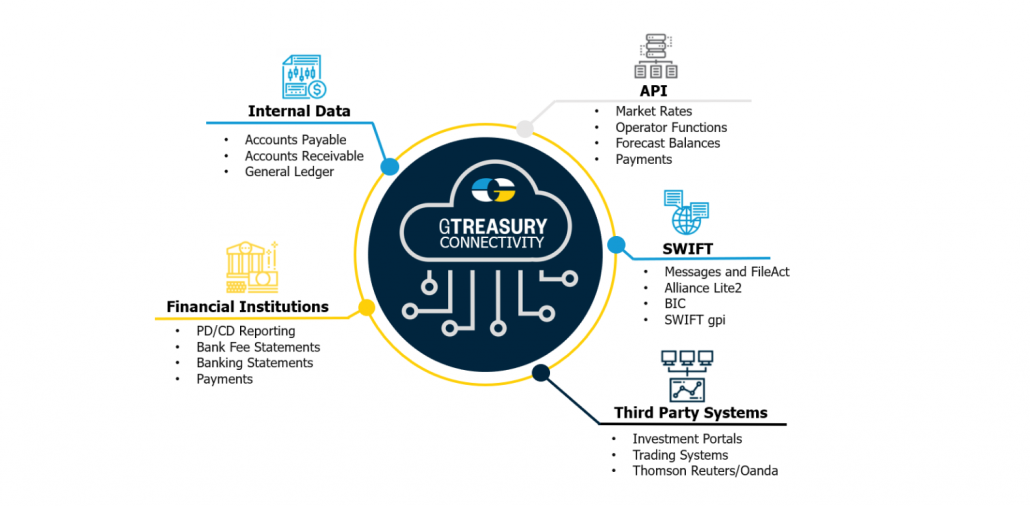
ClearConnect’s market-leading API catalog features over 80 API calls, augmented by host-to-host connectivity wherever needed to bolster capabilities. The solution enables robust functionality across a dozen categories, including payment approval rules, payment workflows, payments and templates, balances and transactions, general ledgers, deal management, bank accounts, bank account management, legal entities, forecasts, operators, and data extracts. ClearConnect’s flexible connectivity architecture uses best-in-class API-enabled connections to ensure fidelity and continuity of customers’ most vital data. Connectivity into Swift, Fides, and others provides a single source of truth and visibility into an organization’s cash and financial risk, and delivers transparent workflows for payments, bank file monitoring, and more.
GTreasury’s always-expanding partnerships with leading global financial institutions and market data partners ensure seamless bank and ERP connectivity, domestic and international transactions, and access to market insights. As client needs change, GTreasury’s active collaborations with product partners further ensure the creation and delivery of modernized products and services, securing ClearConnect’s place as a market-leading solution always aligned with customers’ current data requirements.
From risk management capabilities powered by Moody’s Analytics and KYOS, to market data provided by Refinitiv and Fenics MD, to banking, ERP, investments, and payments partners, ClearConnect now enables customers to wield the full power of the GTreasury ecosystem even more easily and completely.
“ClearConnect doesn’t just offer a significantly greater breadth of connectivity options than anything else available, it also underwrites those capabilities with foundational workflows for data integrity and ease of use,” said Pete Srejovic, Chief Technology Officer at GTreasury. “Investing in API technology only to realize that you are dropping crucial data is a nightmare that has come true for many CFOs and treasury teams. With today’s launch of ClearConnect, we’re proud to offer not only the largest and most powerful API connectivity solution on the market, but one that customers can entrust to deliver absolute data integrity along with the comprehensive and future-proof solutions of the GTreasury ecosystem.”

About GTreasury
12-07-2022 | treasuryXL | Nomentia | LinkedIn |
Recently, treasuryXL partnered with Nomentia on a live webinar on how successful master data management can help you secure financial processes.
Watch the recording of this session for free now by clicking on the image below!
In this webinar, we discussed how you can manage your Master data in a safe way, how you can prevent fraud and sanction risks through the management of this data, and the subsequent processes that make use of your master data. This ranges from the creation of counterparties in your ERP to the safeguard checks in your payment process and system.
More specifically, we will discussed the following topics:
28-06-2022 | treasuryXL | GTreasury | LinkedIn |
With interest rates rising and remaining unpredictable, corporate treasurers need to have a hedging plan in place. For many, this can be easier said than done.
![]()
21-06-2022 | treasuryXL | GTreasury | LinkedIn |

CHICAGO, Ill. – June 21, 2022 – GTreasury, a treasury and risk management platform provider, today announced that it has named Victoria Blake as GTreasury’s Chief Product Officer, and Ashley Pater as General Manager at Hedge Trackers. Recently acquired by GTreasury, Hedge Trackers is the global leader in accounting, consulting, and software services that protect clients against financial risk.
Victoria Blake joins GTreasury with more than 20 years of experience and success in product leadership roles across several SaaS and technology companies. Blake comes to GTreasury from Zapproved, where she served as the Vice President of Product. During her tenure at the e-discovery software provider, she led high-level strategy development, product definition, and market-facing thought leadership and vision. Before Zapproved, Blake was responsible for defining next-generation cloud services offerings as the Vice President of Product Management at Metal Toad, an AWS Consulting Partner. Blake has also held product management and leadership positions at WebMD Health Services, Jive Software, and Walker Tracker.
As GTreasury’s Chief Product Officer, Blake will lead the company’s global product and UX teams in developing and delivering innovative new solutions for GTreasury’s customers and partners. From modern automated treasury and transaction management to AI-powered SmartPredictions™ cash forecasting and visibility, GTreasury’s SaaS platform empowers treasury teams and the office of the CFO with the future-proof technology and capabilities required to drive confident financial decision-making. GTreasury has also continued to expand its broad ecosystem of connected partner technologies, via API integrations with ERPs, banks, and other external providers where instant data connectivity maximizes customer efficiencies.
“GTreasury has built its reputation as a leading treasury and risk management platform by harnessing innovative cloud, AI, machine learning, and emerging technologies that move our industry forward,” said Victoria Blake, CPO, GTreasury. “Just as importantly, GTreasury has always focused on product usability and ensuring that its powerful tools are always easily accessible and seamlessly connected for the teams that rely on them. I look forward to building on what GTreasury has created over the past three decades, and delivering even more next-generation tools to make CFOs and treasury teams more successful.”
Ashley Pater is now the General Manager of Hedge Trackers after more than a decade of leadership roles within GTreasury. Pater most recently served as GTreasury’s Chief Product Officer, where she was responsible for aligning product vision and strategy to the company’s business objectives. Pater previously held leadership positions in GTreasury’s marketing and account management functions, focusing on building global brand awareness, lead generation, event management, and cross-sell programs.
Pater will oversee daily business operations and lead growth strategy around Hedge Trackers’ FX, interest rate, and commodity price risk management services and consulting. Pater will also ensure alignment and integration opportunities within the broader GTreasury organization. Hedge Trackers offers best-in-class expertise and technical depth in meeting today’s unprecedented demand for effective hedging strategies, identifying exposure, managing risk, and meeting compliance and audit requirements. Under Pater’s leadership, Hedge Trackers will focus on bolstering its risk management expertise and bringing new solutions to market across the company’s risk product suite.
“Combining the strengths of GTreasury and Hedge Trackers makes us the clear market leader when it comes to both our treasury risk management products and our consulting acumen,” said Ashley Pater, General Manager, Hedge Trackers. “Today’s CFOs and financial leaders understand that risk management and hedging capabilities are critical to navigating volatile markets and achieving larger business goals. I’m excited to further our solutions and insight to equip customers with the solutions required for effectively and cost-efficiently managing their risk.”
“Both Victoria and Ashley possess the clarity of vision required to advance our GTreasury and Hedge Trackers products to meet our customers’ evolving needs today and well into the future—and both bring relevant, experienced, and proven leadership to accomplish those goals,” said Renaat Ver Eecke, CEO, GTreasury. “I’m glad to welcome Victoria and Ashley into their new roles and look forward to what’s to come from GTreasury and Hedge Trackers.”
About GTreasury
GTreasury is committed to connecting treasury and digital finance operations by providing a world-class SaaS treasury and risk management system and integrated ecosystem where cash, debt, investments and exposures are seamlessly managed within the office of the CFO. GTreasury delivers intelligent insights, while connecting financial value chains and extending workflows to third-party systems, exchanges, portals and services. Headquartered in Chicago, with locations serving EMEA (London) and APAC (Sydney and Manila), GTreasury’s global community includes more than 800 customers and 30+ industries reaching 160+ countries worldwide. Visit GTreasury.com
17-06-2022 | treasuryXL | Cashforce | TIS
Treasury Intelligence Solutions (TIS), a global leader in enterprise payment optimization, today announced their acquisition of Cashforce, an AI-powered provider of cash management and forecasting solutions.
This acquisition will see Cashforce’s leading cloud solution – currently deployed at many of the largest and most sophisticated corporate treasuries in the world – become integrated with TIS’ SaaS payments platform. This unified solution will provide enterprises with an unmatched suite of capabilities for cash management, global payments, and fraud mitigation along with superior connectivity, workflows, and reporting functions.
Over the past few years, TIS and Cashforce have collaborated closely to provide a complementary offering for treasury and finance teams. These efforts were met with immediate success in the market as demand for improved cash management and forecasting tools has risen sharply. Now, TIS’ acquisition of Cashforce presents the perfect opportunity to integrate both products together as part of a more complete offering.
For the thousands of enterprise treasury and finance practitioners who currently use TIS, this acquisition provides access to faster and more accurate cash reporting, forecasting, and working capital management. To date, cash positioning and forecasting are still being performed manually by many treasury groups, which represents a major pain point for CFOs and business leaders when attempting to make strategic financial decisions. However, the robust capabilities provided by Cashforce eliminate many of these inefficiencies and ultimately enable companies to gain quick and accurate insights into their financial position based on reliable payments and liquidity data.
According to Erik Masing, Group CEO of TIS, “Cashforce has been a premier partner of TIS for several years and has contributed significantly to the cash forecasting and management capabilities we offer clients. The acquisition is a natural extension of our business and will allow TIS to further integrate Cashforce’s solution with our platform in order to offer advanced forecasting and data management capabilities to all our clients. This means enterprises can significantly reduce complexity in their global payments and cash management tech stacks by leveraging standardization and transparency afforded by a single, elegant solution.”
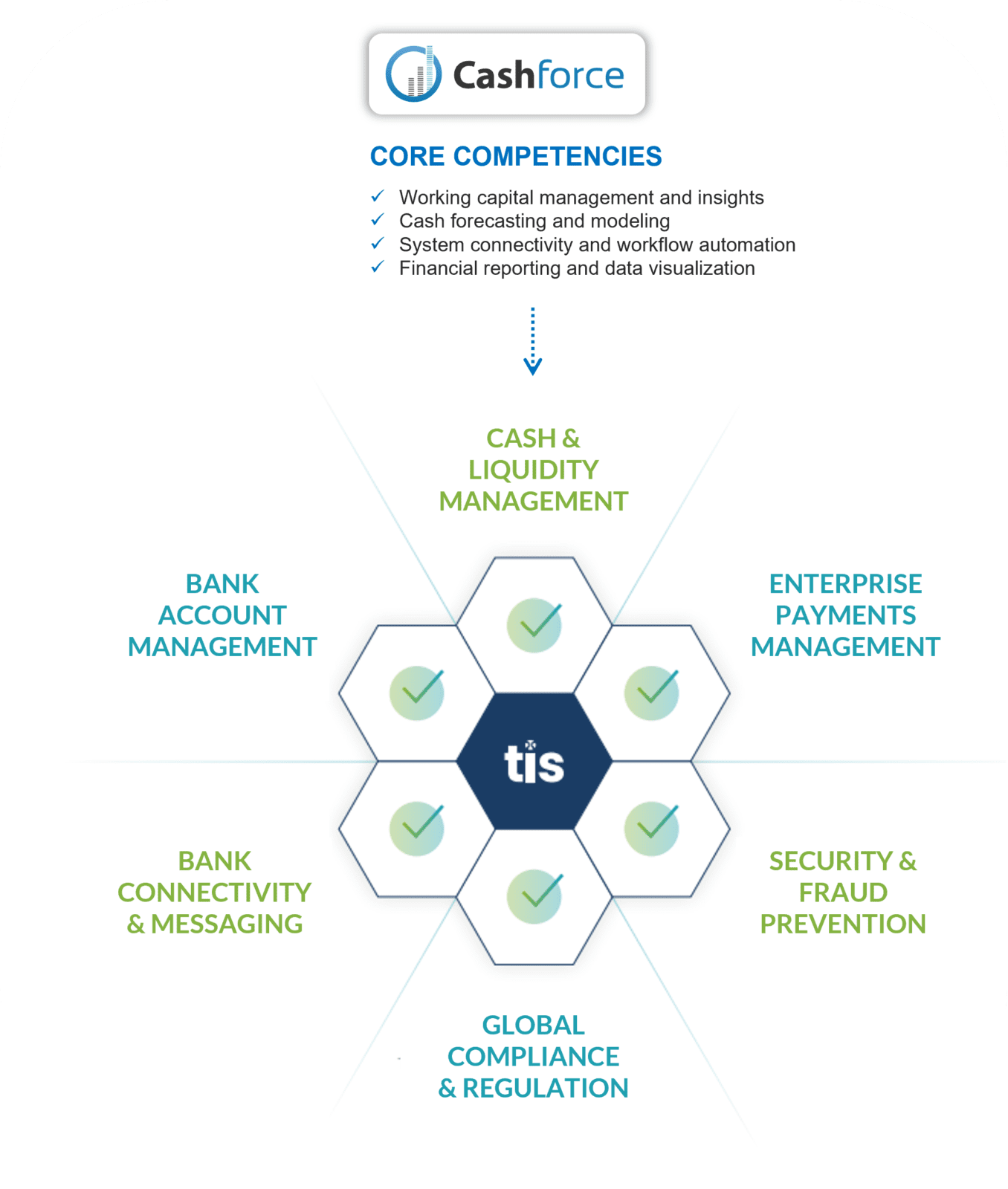
For Cashforce, the acquisition means that existing clients can now supplement their robust forecasting capabilities with TIS’ industry-leading payments and bank connectivity features. As explained by Nicolas Christiaen, Founder and CEO of Cashforce, “Giving businesses complete visibility over their cash and liquidity data has always been the core objective of Cashforce. While we have spent years perfecting our capabilities in this regard, TIS has been strengthening their suite of payments, bank connectivity, and cash management tools. When combined, these two sets of capabilities form the ideal solution for global treasury and finance teams to achieve full control and visibility over their entire payments and liquidity architecture – including all entities, back-office systems, and banks.”
With the added capabilities of Cashforce’s solution, TIS now offers a single, scalable cloud platform for clients to address needs in the following areas:
For more information on TIS’ acquisition of Cashforce and the advantages our combined solution will provide to enterprise treasury, finance, and executive teams, contact us at [email protected] or by using the information found on our website.
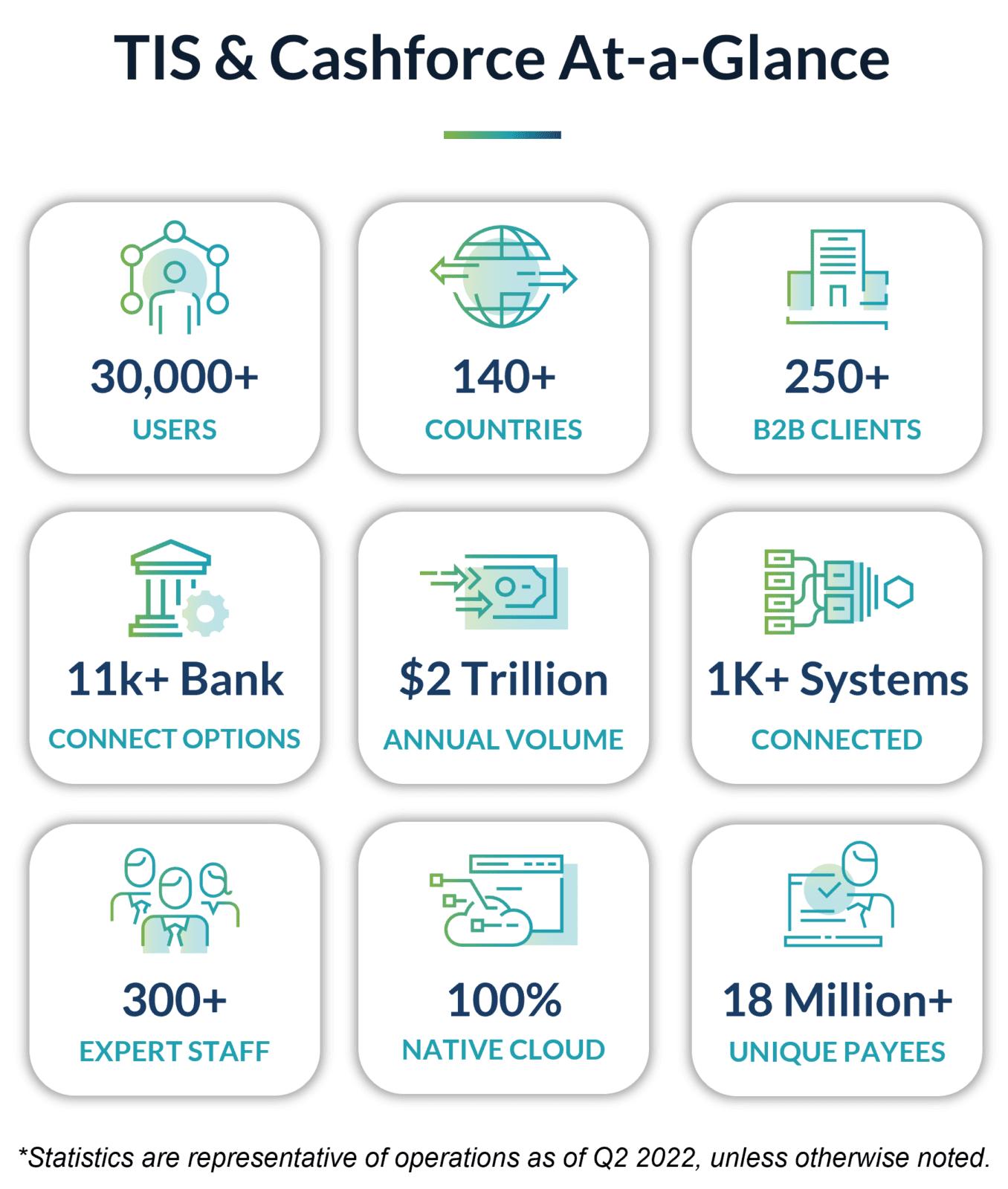
About TIS
TIS is reimagining the world of enterprise payments through a cloud-based platform uniquely designed to help global organizations optimize payments, manage cash visibility, and mitigate risk. Corporations, banks, and business vendors leverage TIS to transform how they connect global accounts, collaborate on payment processes, execute outbound payments, analyze cash flow and compliance data, and improve critical outbound payment functions. With $2 trillion in payments processed annually, the TIS corporate payments platform helps businesses improve operational efficiency, lower risk, manage liquidity, gain a strategic advantage – and ultimately achieve enterprise payment optimization.
Visit us for more information at https://www.tispayments.com.
16-06-2022 | treasuryXL | Refinitiv | LinkedIn |
Demand for real-time data is growing fast as financial firms face regulatory, trading, operational and competitive challenges. Rob Lane, head of real-time feeds at Refinitiv, discusses the changing data needs of banks and buy-side firms and how the cloud is helping improve access to a key source of competitive advantage in pursuit of more informed and agile decision-making.
15-06-2022 | treasuryXL | TIS | LinkedIn |
This blog highlights the primary considerations that treasury and IT teams must make when determining whether to build custom in-house bank connectivity and payments solutions or contract the services and software of a specialized 3rd party vendor. After evaluating the main benefits and drawbacks of each option, we provide a list of helpful questions for practitioners to consider as they decide whether building or purchasing a solution best suits their needs.
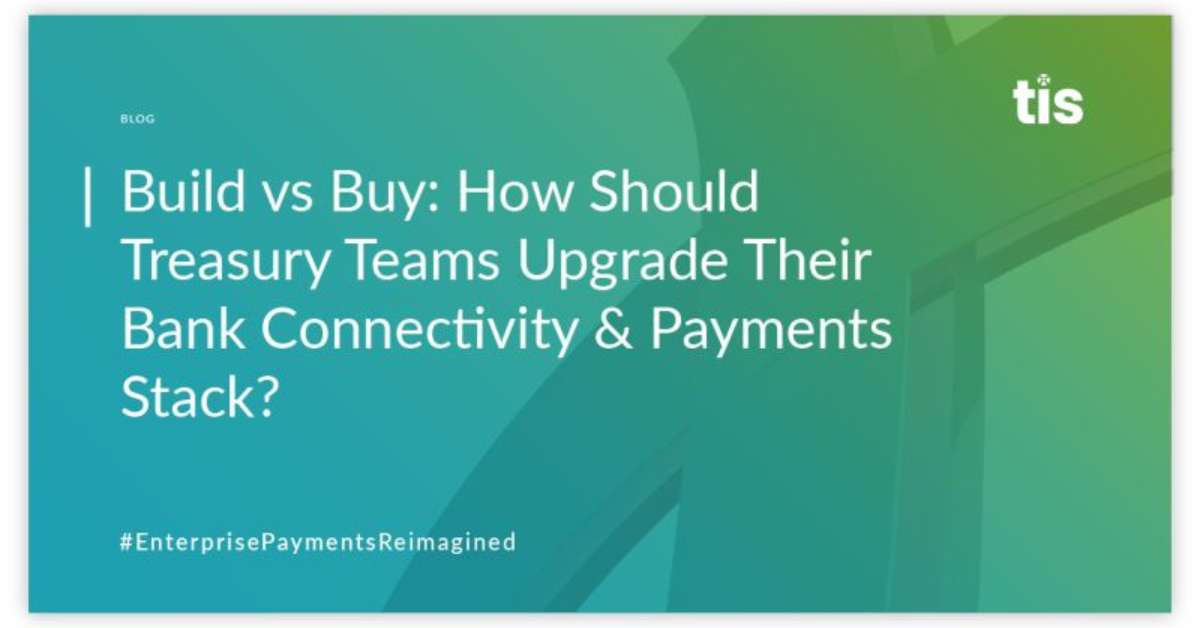
In today’s remote and digitally operated business environment, it’s no secret that organizations have grown deeply reliant on technology to manage and automate their core treasury and finance functions.
Realistically, a “modern” company operating in 2022 will be doing business through a myriad of banks, accounts, currencies, and entities. They will also likely have hundreds or thousands of vendors, partners, and customers within their network. As a result, digital payments and cashflows are moving in and out of the business constantly, and every movement must be monitored and controlled by treasury teams that often consist of just a few employees.
Because of treasury’s limited personnel bandwidth, any issues with adopting the right bank connectivity and payments stack to automate their core operations almost always lead to excess complexity and manual strain. It can also result in significant security and compliance gaps, along with general inefficiency across crucial processes like transaction processing, liquidity management, balance reporting, and cash forecasting.
But while most treasury and IT groups today can agree that developing a robust connectivity and payments stack is critically important, each internal stakeholder will likely have their own idea regarding what the “best-fit” version of this technology stack actually looks like.
Why is this?
As companies grow over time, the systems they use to manage payments and connect with their banks must evolve accordingly. Because managing a few bank accounts and transactions in a single country and currency is a fundamentally different task compared to managing dozens of banks, hundreds of accounts, and thousands of payments across numerous countries and currencies, companies cannot rely on the same solutions and structure they’ve always used to sustain them as they scale.
Instead, in order to maintain compatibility with new payment formats and channels like ISO 20022 and SWIFT GPI, connect with regional payment networks like NACHA and EBICS, or accommodate custom bank connectivity protocols (Host-2-Host / SFTP, APIs, etc.), growing enterprises will inevitably reach a point where their existing payments and banking architecture must undergo a significant overhaul.
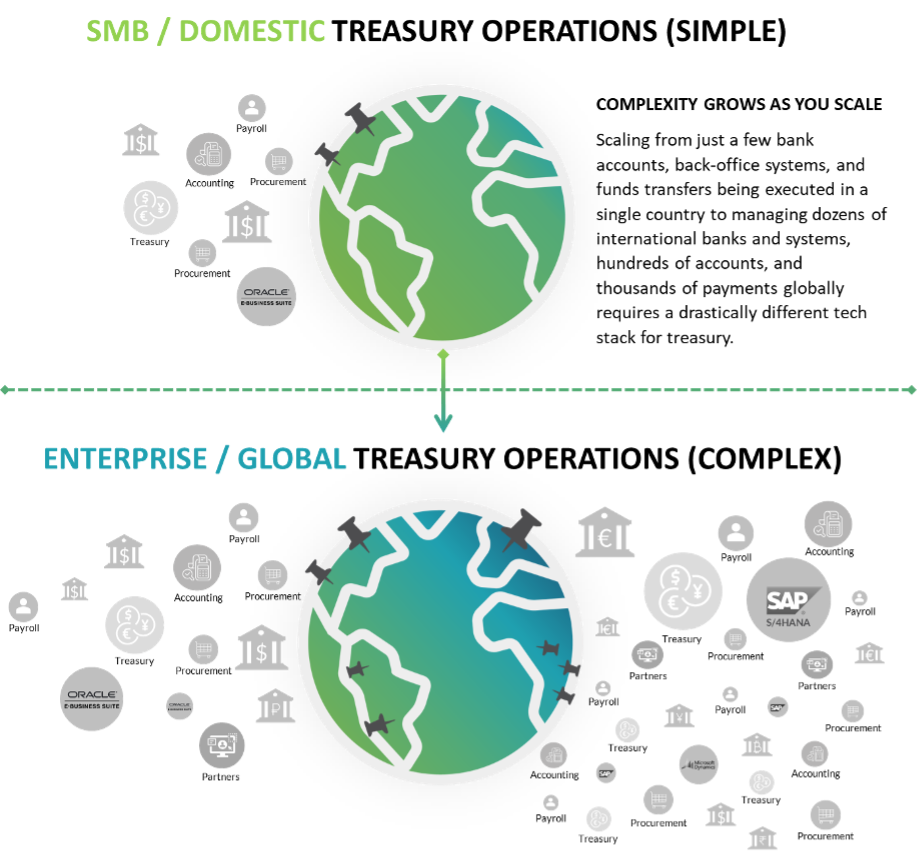
However, as this evolution occurs and internal stakeholders recognize the need to upgrade their connectivity architecture, disagreements often arise over which vendor or “type” of solution is the best fit. Given that there are hundreds of available 3rd party solutions that could potentially address treasury’s requirements, as well as a variety of internally developed applications that could be created and deployed by IT teams, it is common for different stakeholders to have contrasting views over which option is the smartest choice.
This is where the “Build vs Buy” technology argument most frequently comes into play.
As organizations recognize the need to upgrade their payments and connectivity capabilities, there are two main approaches they could leverage to address the issue. The first is to use internal IT resources and expertise to build a customized solution for treasury, and the second is to purchase a specialized solution from a 3rd party provider.
But which option is the best choice?
Let’s quickly review the key benefits and drawbacks of each option.
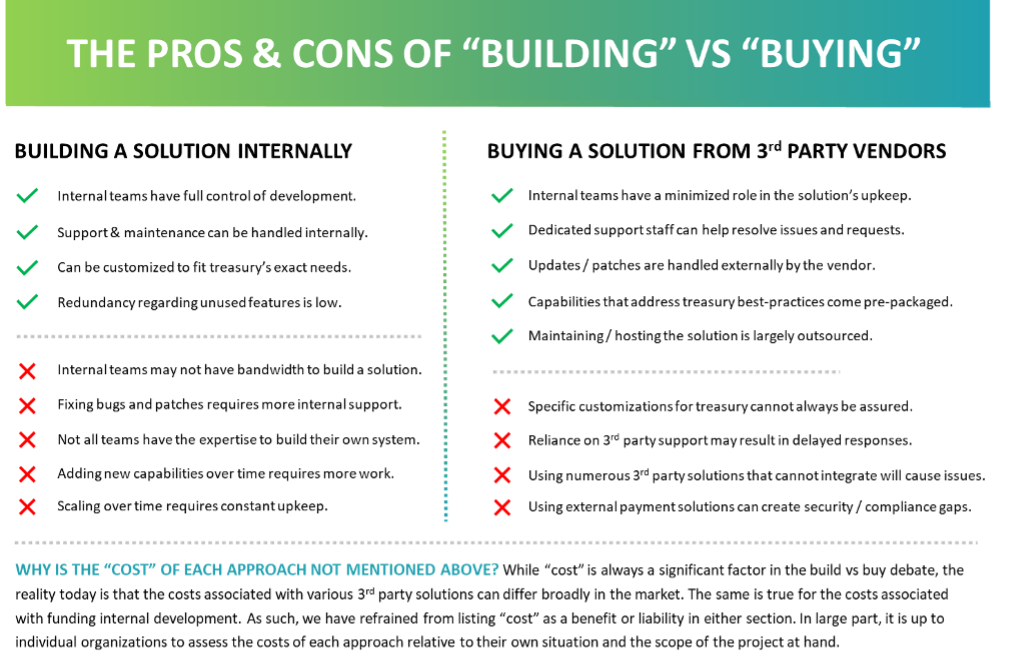
Organizations that prefer to create their own custom connectivity solutions internally using IT resources and expertise will likely have a greater ability to customize the offering in a manner that best addresses all their needs. To date, several prominent ERPs offer modules or plugins that give IT staff the ability to build custom formats and configure their own connectivity protocols. However, this option requires a significant amount of bandwidth and maintenance from treasury and IT teams, as well as a high degree of expertise and technical prowess to support the solution over time. The below pros and cons list highlights this reality in more detail.
PROS
CONS
Compared to building an internal solution, adopting a 3rd party connectivity and payments solution usually requires less of treasury and IT’s time, and there is less effort required to develop, implement, and maintain the solution. However, there is also the chance that this solution will require the purchase of redundant or unnecessary features. At the same time, improper or incomplete implementation of a 3rd party solution can cause severe integration, security, and compliance issues over time. More about these pros and cons are highlighted below.
PROS
CONS
As showcased by the above bullets, a company’s decision to build or buy its payments and connectivity solutions should always depend on its unique circumstances. For instance, a company with sufficient IT personnel and internal expertise might have the bandwidth to create and maintain a solution on its own. However, if treasury and IT teams are already exasperated with their current list of responsibilities and don’t have the time or expertise necessary to create and maintain their own solution, it probably makes more sense to begin evaluating the services of a 3rd party provider.
For treasury teams who are presently evaluating their options and need help deciding on the best course of action, the following considerations will help provide more clarity during the decision-making process.
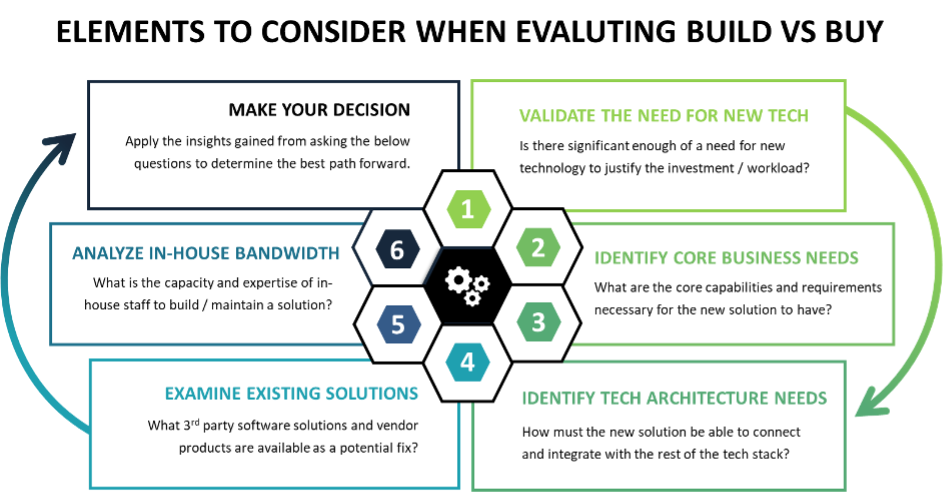
1. Validate the Need for New Technology
Many organizations have their eye on new technology before identifying any legitimate business need. Sometimes this “cart before the horse” approach is due to rigid business processes, lack of technical knowledge, or pure product hype. Decision-makers are very often awed by product suite success stories, dynamite product demonstrations, and industry analysts’ evaluation of technology—even when they haven’t formally identified a need for the technology.
To avoid these pitfalls, treasury and IT teams need to first validate the need for upgraded connectivity and payment protocols, prior to even beginning to evaluate which solution makes the most sense.
Last, but not least, tech leaders need to provide an estimated return on investment (ROI) for any new solution, along with a description of how ROI will be measured. It is surprising how many programs are initiated without considering ROI or added business value upfront. Many of these projects consume a lot of budget and time before leaders realize that either the solution will not add value or there is not a legitimate business need.
2. Identify Core Connectivity & Payment Requirements
In large organizations, pinpointing core connectivity requirements is often easier said than done. Still, it is a critically important step to take before deciding to implement a new solution. A core business requirement is one that must be supported by the solution to continue functioning as intended. For multinational organizations, core connectivity requirements may involve compatibility with numerous format types (EDI, BAI, SWIFT MT, ISO 20022, etc.) as well as numerous bank channels (SWIFT, H2H, EBICS, etc.) and back-office integrations (APIs and plugins for ERPs or TMSs).
Although determining treasury’s exact connectivity requirements may be difficult, it is extremely important to identify these core functional requirements first—not technology or design requirements. This is the only way to ensure unnecessary or redundant functionality is not purchased erroneously, and also ensures that critical requirements are never accidentally overlooked and unaddressed through whatever solution is ultimately chosen.
3. Consider Your Technology Architecture Requirements
Going a step further than the above point, it’s safe to assume that organizations are already using technology to enable other business processes. To reduce the cost and liability of this technology, your organization has also likely adopted standards related to how internal solutions are implemented and maintained.
As such, it is extremely important to identify any architectural requirements or standards that a solution must adhere to before determining if a 3rd party solution or an internal solution is the best choice. Some factors that may restrict the solution choice are as follows:
4. Examine & Evaluate Existing Solutions FIRST
At this point, a business need has been pinpointed, ROI has been estimated, and both core business and architectural restrictions have been identified. Leaders should now take a good look at existing systems.
It is not uncommon that different departments or entities of a large, global organization are not aware of what systems exist in other areas of the company. As a result, businesses will often implement multiple versions or forms of the same technology, only to discover that another system within the organization could have supported treasury’s new requirements with little to no modification. Thus, before deciding on the “best-fit” solutions approach, you should determine if any existing system(s) within the organization can be easily scaled or extended to meet your business need.
5. Compare In-House Expertise & Bandwidth Relative to Current AND Future Capabilities Required
One major factor that can significantly reduce the ROI of a custom-built solution (and in many cases, ultimately causes the project to fail) is the lack of available personnel with proper skill sets. In reality, the process of designing and deploying custom connectivity solutions that are both scalable and extensible is a massive undertaking for both treasury and IT. Unless one of your business areas is product development or you have an abundance of available IT support, there is an extremely high probability that your operations and maintenance technology resources will not be able to build, sustain, and support an internal solution, especially as new needs and requirements arise over time.
It is never profitable to let personnel gain these skills and experience by developing business-essential systems. Yet, more often than not, decision-makers see the short-term cost differences between an internally-built vs 3rd party solution and decide to try and build their own in order to save money. However, unless you’re supremely confident in the skillsets and bandwidth of both your treasury and IT teams, this option is not recommended.
Why TIS is the Ideal Provider for Global Payments, Liquidity Management, & Bank Connectivity
Ultimately, any organization evaluating whether to build or buy its next solution will have to closely analyze its own operations in order to make the best decision.
In cases where organizations require support for a complex array of payments and bank connectivity protocols and are open to considering a 3rd party vendor, they should closely evaluate the capabilities provided by TIS.
The cloud-based, fully-supported platform provided by TIS offers a global, multi-channel, and multi-bank connectivity ecosystem that streamlines and automates the processing of a company’s payments across all their global entities and systems. By sitting above an enterprise’s technology stack and connecting with all their back-office, banking, and 3rd party solutions, TIS effectively breaks down department and geographic silos to allow 360-degree visibility and control. To date, the ~200 organizations that have integrated TIS with their global ERPs, TMSs, and banking landscape have achieved near-100% real-time transparency into their payments and liquidity. This has benefitted a broad variety of internal stakeholders and has also enabled them to access information through their platform of choice since the data that passes through TIS is always delivered back to the originating systems.

Because of the deep connections that TIS maintains with internal systems such as ERPs or TMSs, external banks, and 3rd party vendors, the process of managing payments is simplified for every internal stakeholder. C-suite executives, treasury, accounting, AP, legal, HR, and other key personnel can access whatever financial data they need, exactly when they need it. And by automating this flow of information for both inbound and outbound payments, TIS provides the control and flexibility that enterprises need to function at their highest level.
Finally, with the global payments data we have amassed and the decades of experience our team has in orchestrating enterprise payments, we are uniquely equipped to help enterprises accurately benchmark their payments performance and provide tailored advice on how to optimize, grow, and mature. Ultimately, this rich data and deep experience are what enable us to continually provide industry-leading payment solutions and support to our enterprise customers.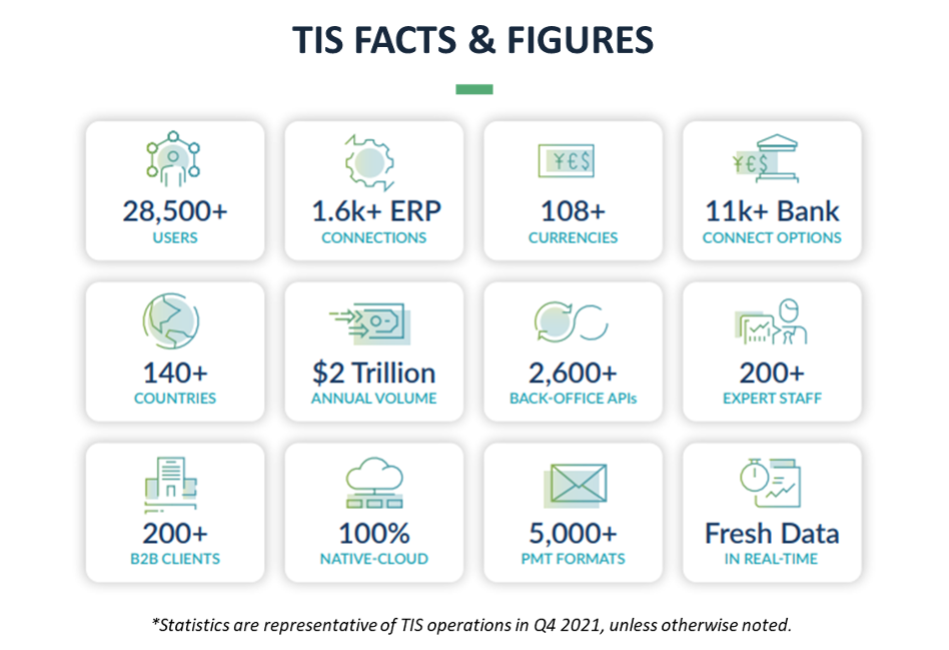
In the digital world of enterprise payments, TIS is here to help you reimagine and simplify.
For more information about how TIS can help you, visit our website or browse our latest resources!